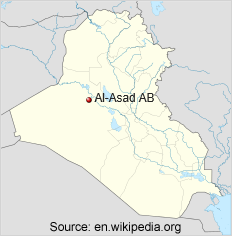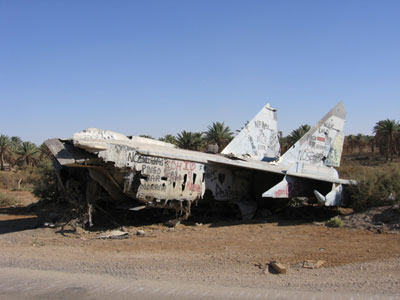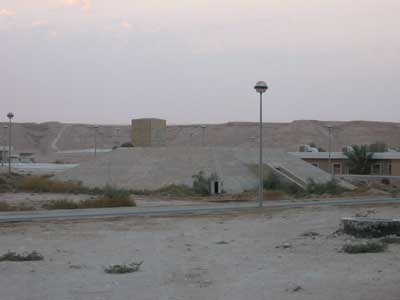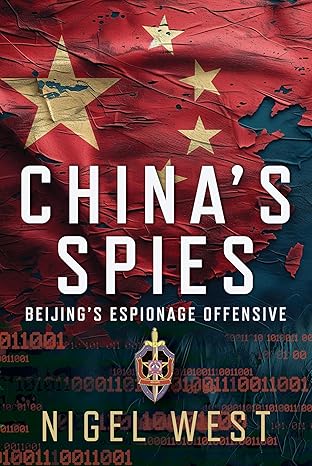A Brief History of Al Asad Air Base, Iraq During Operation Desert Storm
By Bryan Dickerson
| [Author’s Note: The author is a former Navy Reserve Religious Program Specialist 1st Class (Fleet Marine Force). He served at Al Asad Air Base in the fall of 2005 and again from October 2009 to February 2010 as part of the 2nd Marine Aircraft Wing / II Marine Expeditionary Force. This article was written from unclassified sources supplemented by his personal recollections in several areas. The author freely acknowledges that there may be classified information related to Al Asad Air Base not available to him which might change the interpretations and facts presented herein.] |
From early 2004 until late 2011, Al Asad Air Base was one of the most important air bases used by Coalition Forces during Operation Iraqi Freedom. For most of this time, this sprawling base located in the Al Anbar Province of western Iraq was operated by the U.S. Marine Corps to conduct aerial operations and support ground operations throughout the province. The history of this base, however, dates back to the mid-1980s. During Operation Desert Storm in 1991, Al Asad Air Base was subjected to numerous air attacks, sustaining massive damage. Al Asad’s role in Operation Desert Storm is thus the subject of this paper.
The Construction and Early History of Al Asad Air Base
Al Asad Air Base is located in the central portion of Al Anbar Province, western Iraq, some 12 miles from the city of Baghdadi and the Euphrates River. Baghdad is 120 miles to the east; the Syrian border is about 110 miles to the north-west.
The area in which the future Al Asad Air Base would be constructed had a sporadic history that stretched back to Biblical times. Arab legend purported that Abraham and his family stopped at an oasis here during their journey from Ur to Haran. However, there is no mention of this in either the Bible or the Quran. This area was virtually uninhabited until the 1920s when several Iraqi families settled here and established a village known as Eyen Al Asad or “Spring of the Lion.”[1]
In 1985, Saddam Hussein decided to have an air base constructed in the vicinity of the village of Eyen Al Asad and its oasis. He hired Yugoslavians to construct the base. The villagers were paid a small fee for the land and forcibly relocated to Baghdad and other cities in Al Anbar. A few villagers remained behind and lived unnoticed until being discovered in 1995 when the base was expanded to include the oasis and village. Then they too were removed and re-settled elsewhere against their will.[2]
The air base was originally named Al Qadisiyah Airbase after the May 636 defeat of the Persians by Arab Muslims at the village of Qadisiyah south of Baghdad. As early as 1990, Qadisiyah was commonly referred to as Al Asad Air Base and that is the name that has been used exclusively since 2003.
The base was constructed in and around the valley (wadi) of a small stream that flowed into the Euphrates River several miles to the east. Two runways in excess of 13,000 feet and two equally long taxi-ways were located on the plateau above the wadi. Approach ramps descended into the wadi and connected with hangars, hardened aircraft revetments and operations bunkers. Scattered around the perimeter of the runways were revetments for anti-aircraft guns. Additional hangars and revetments were located on the south side of the runways. Located in the wadi were barracks, command bunkers and various support buildings. Recreational facilities and other amenities for the Iraqi personnel assigned to the base included a mosque, theater, a soccer stadium and an indoor pool.[3]
 Al Asad Air Base was constructed from the experiences gained during the Iran-Iraq War of the 1980s. At the onset of the war, the Iraqi Air Force (IQAF) had attempted to destroy the Iranian Air Force on the ground, but was unable to do so because the Iranian aircraft were protected in hardened structures. Accordingly, Al Asad and other new IQAF air bases were designed to survive enemy air strikes and recover quickly from them. Older air bases were upgraded as well. These hardened aircraft shelters were constructed by Yugoslav contractors to Warsaw Pact construction standards.[4]
Al Asad Air Base was constructed from the experiences gained during the Iran-Iraq War of the 1980s. At the onset of the war, the Iraqi Air Force (IQAF) had attempted to destroy the Iranian Air Force on the ground, but was unable to do so because the Iranian aircraft were protected in hardened structures. Accordingly, Al Asad and other new IQAF air bases were designed to survive enemy air strikes and recover quickly from them. Older air bases were upgraded as well. These hardened aircraft shelters were constructed by Yugoslav contractors to Warsaw Pact construction standards.[4]
Some thirty-three hardened aircraft shelters and bunkers were located throughout Al Asad. Two 13,200-foot runways and two equally long taxi-ways were constructed to handle high performance aircraft. The other purpose of the long runways was to enable air operations to continue if part(s) of the runways were damaged. Numerous hardened anti-aircraft artillery positions were situated to defend against enemy air attack. SAM sites were also located around the air base. In the event that the air base sustained damage, the Iraqis also had ample equipment and supplies for rapid runway / taxiway repairs.[5]
Three basic types of aircraft protective structures were constructed at Al Asad. There were 12 “Yugoslav” shelters, 6 Tab Vee shelters and 20 concrete hangars recessed into the sides of the wadi. The hangars had no protective doors. The Tab Vee shelters were strongly built, meeting or exceeding NATO construction standards. However, they had little internal storage capacity and could only hold a couple aircraft. Accordingly, the Iraqis built bunkers nearby for personnel and munitions. The so-called “Yugoslavs” were large aircraft bunkers designed by the Yugoslavians. They came in two variants: single bay drive-in and single bay drive-through. Attached to the Yugoslavs were annexes for personnel, munitions, equipment and tools. Each could hold four to six aircraft. These hardened aircraft structures were constructed of concrete several feet thick. As Air Force Intelligence Support Agency threat analyst Christopher M. Centner pointed out in a 1992 Airpower Journal article, “Iraq hadn’t built mere airfields; it had built fortifications.”[6]
Typical of Al Anbar’s climate, Al Asad’s weather was oppressively hot and dry during the summer with daily temperatures well in excess of 100 degrees and cold and rainy during the fall and winter. Sandstorms were a frequent occurrence in the fall, winter and spring.[7]
Al Asad Air Base became home to three IQAF fighter squadrons. At various times, Soviet-made modern MIG-25 Foxbat and MIG-29 Fulcrum fighters were based here along with Vietnam-era Soviet MIG-19s and MIG-21s and their Red Chinese equivalents F6 and F7. The Iraqis also used the air base to store chemical weapons. Following Operation Desert Storm, Iraqi officials reported that they had stored nearly 700 bombs containing nerve agents and the blister agent mustard gas at Al Asad.[8]
Operation Desert Storm
By 1990, Al Asad Air Base was one of the Iraqi Air Force’s major fighter aircraft installations. Just a few years after its construction, Saddam Hussein invaded Kuwait in August 1990 and provoked a massive U.S./United Nations military response. Following a several months long build-up, U.S.-led Coalition Forces unleashed a massive air campaign on 17 January 1991 to force Saddam to withdraw from Kuwait.
On paper, the Iraqi Air Force and Iraqi air defenses looked formidable. The IQAF had over 700 tactical aircraft including forty-five modern MIG-29 Fulcrum fighters, forty-eight Su-24 Fencer fighters, and forty SU-25 Frogfoot attack aircraft purchased from the Soviet Union. The IQAF also had sixty-five French F-1 Mirage fighters. These aircraft operated from twenty-four main bases and thirty dispersal bases located throughout the country. The Iraqi Air Defense system relied upon a French-made command and control system, over 2,400 fixed anti-aircraft guns, 6,100 mobile anti-aircraft guns, 972 anti-aircraft artillery sites, and over 3,600 surface-to-air missiles.[9]
Though possessing one of the largest air forces in the Middle East and in the world, the Iraqi Air Force was far less capable than it appeared. The IQAF was primarily oriented to support the Iraqi Army and as such, its best pilots and resources were dedicated for that purpose. Though possessing some of the most modern fighter aircraft in the world, the Iraqis relied primarily upon surface-to-air missiles and anti-aircraft artillery for air defense. “The Iraqis never intended to contest for control of the air,” reported the U.S. Air Force’s 1993 Gulf War Air Power Survey. “They hoped to preserve most of their air assets for use when the ground war started or even for the postwar period after the war’s outcome.” In addition, as 1st Lt Matthew M. Hurley, USAF, pointed out in a 1992 Airpower Journal article about the IQAF performance in Desert Storm, “A painfully obvious lesson of twentieth-century warfare, proven time and again, is that modern weapons are a waste of resources without operators who are willing and able to use them.”[10]
Several years after Desert Storm, the commanding general of the Coalition’s air forces General Chuck Horner, USAF, collaborated with author Tom Clancy to write an extensive memoir of his experiences entitled Every Man a Tiger: The Gulf War Air Campaign. In it, he wrote the following assessment of the Iraqi Air Force:
| I had studied the Iraqi Air Force for years, and had found many strengths, including a number of first-rate aircraft equipped with adequate missiles, a comprehensive command and control structure, and a few excellent pilots. Its single greatest weakness was its reliance on centralized command and control; but the training its pilots received was not uniformly good, and the logistics support was shaky.[11] |
When the U.S.-led Coalition air forces launched the Air Campaign against Iraq in mid-January 1991, one of the highest priorities was to neutralize and/or destroy the Iraqi air defense system and the Iraqi Air Force. Nearly every IQAF air facility was struck in the first three days of the campaign. Runways had to be hit repeatedly because they could still function so long as 3,000 feet of unbroken surface remained. Iraqi fighters offered sporadic resistance to Coalition aircraft ravaging Iraqi defenses; few survived the ensuing aerial combats against Coalition fighter aircraft.[12]
After several days of aerial defeats, the IQAF opted to hide their remaining aircraft in the 594 hardened aircraft bunkers scattered across Iraq. These structures were some of the best constructed in the world. So Coalition forces undertook a vigorous campaign to destroy the bunkers and the aircraft they contained. This proved very successful as 63% of the bunkers were ultimately destroyed. After a few days of this severe pounding, Saddam Hussein decided to send his remaining aircraft to Iran in the hopes of saving them from destruction and retrieving them later. Those aircraft not fleeing to Iran were dispersed throughout residential, historical and cultural areas, spending the remainder of the war in hiding.[13]
In Every Man a Tiger, Gen. Horner described the destruction of the Iraqi Air Forces. He noted that Coalition air forces seized control of the Iraqi air space and were victorious in nearly every air-to-air engagement. He wrote:
| After that, they tried to hide in their heavily defended aircraft shelters, also to no avail, when we picked off the shelters, one at a time, with 2,000-pound laser-guided bombs.[14] |
Along with the other Iraqi airfields, Al Asad Air Base was targeted early in the Air Campaign by Coalition aircraft. A typical air strike against the base consisted of fighter aircraft such as U.S. Air Force F-15C Eagles and F-16 Fighting Falcons and U.S. Navy F/A-18 Hornets and F-14 Tomcats to handle air-to-air threats. Suppression of Enemy Air Defenses (SEAD) was performed by Royal Air Force GR-1 Tornadoes, U.S. Navy A-7 Corsair IIs and U.S. Air Force F-4G Wild Weasels. USAF EF-111A Ravens and Navy EA-6B Prowlers provided electronic warfare support including radar and communications jamming. The actual air strikes against the air base were conducted by RAF GR-1 Tornadoes and Buccaneer attack aircraft, Navy A-6B Intruders, USAF F-111F Aardvarks, F-15E Strike Eagles and USAF F-117A stealth fighter/bombers. “Operation DESERT STORM featured the F-117A in its first real world test against a modern, integrated air defense,” wrote Senior Master Sergeant Harold P. Myers, USAF (Ret.) in his Nighthawks over Iraq.[15]
A variety of air munitions were used in Coalition air attacks on Al Asad Air Base. The RAF used JP233 munitions against the runways. Each JP233 consisted of 30 concrete penetrating bomblets and 215 area denial bomblets. The former would crater the runways while the latter with their variable time and disturbance fuses would delay the enemy from repairing the damage.
Such attacks required the Tornadoes to fly extremely low, oftentimes through concentrated Iraqi anti-aircraft fire. Precision guided bombs and missiles were used against the hardened aircraft structures and bunkers. 2,000-pound case-hardened laser guided bombs (GBU-24) were especially useful against these targets for their ability to penetrate the thick concrete structures.[16]
The first strike against Al Asad was conducted by the British Royal Air Force. At 0350 local time 17 January 1991, four GR-1s supported by two GR-1s with ALARMs (Air Launched Anti-Radiation Missiles) hit the air base.[17]
Around 1700 on the afternoon of 17 January, two MIG-29 Fulcrum fighters were detected flying south by a U.S. Air Force AWACS aircraft, presumably having taken off from Al Asad. Four F-15C Eagles were vectored for an intercept. The MIGs attempted to escape but then suddenly turned on their pursuers. Marine Corps Capt Charles J. Magill and Air Force Capt Rhory R. Draeger destroyed the two MIGs with AIM-7 missiles.[18]
Al Asad was struck again later that day. Around 2300 local time, eight RAF GR-1s bombed the air base. U.S. Navy F-14s, F/A-18s, EA-6Bs and A-7s provided fighter cover and SEAD support.[19]
On 23 January 1991, Coalition air forces began their aircraft bunker busting campaign. Al Asad was hit by U.S. Air Force F-111Fs on three consecutive nights. At 2200 on 23 January, eight F-111Fs from the 48th Tactical Fighter Wing each dropped four GBU-10s or GBU-24s on the bunkers while twelve other F-111Fs hit the runways. Twenty more F-111Fs hit the base the following night and then twelve more on the night of 25 January. According to Major General Alwan Hassoun Alwan al-Abousi of the Iraqi Air Force, approximately fifty Iraqi fighters were bombed at Al Asad at this time.[20]
In the early morning hours of 25 January 1991, the Air Force’s stealth F-117As made their first air strike against Al Asad Air Base. F-117As of the 37th Tactical Fighter Wing (Provisional) (TFW(P))’s 416th Tactical Fighter Squadron dropped nine GBU-27s on aircraft bunkers. Al Asad was one of three airfields that night attacked by the 416th Tactical Fighter Squadron. They returned the next night and dropped more bombs on Al Asad’s bunkers.[21]
The 37th Tactical Fighter Wing launched two more air strikes against Al Asad on the following day. The first strike was planned as part of a larger mission against two other airfields, a munitions depot and a joint integrated operations center/ground control intercept site located at Al Mawsil. Al Asad, however, was not the original target of the second strike launched later that night. Thirteen F-117As from the 415th and 416th Tactical Fighter Squadrons launched on a strike against three airfields, a command and control center and an air defense control site. Finding their primary target, Qayyarah West Airfield, obscured by bad weather, several of the F-117As diverted to Al Asad and plastered it with seven direct hits.[22]
By the beginning of February, Coalition air forces had complete supremacy of the skies above Kuwait and Iraq. With the Iraqi Air Force and air defenses neutralized, Coalition air forces shifted their attention to destroying the Iraqi ground forces and their critical support infrastructure.
Despite the shift in priority to ground forces, Iraqi air bases were periodically hit during the month of February. On 13 February, Al Asad Air Base was struck by three separate air attacks. At 0810 six RAF GR-1 Tornadoes struck the runways and hardened aircraft shelters. The Tornadoes were supported by two other GR-1s equipped with ALARM (Air Launched Anti-Radiation Missiles), two U.S. Navy F/A-18 Hornet fighters and two EA-6 Prowler electronic warfare aircraft. A half-hour later, a U.S. Air Force / RAF group hit the air base. The U.S. Air Force provided suppression of enemy air defenses (SEAD) coverage with two F-15 Eagles, two F-4G Wild Weasels and two EF-111 Ravens. With two RAF Buccaneer attack aircraft providing laser target spotting, four Tornadoes struck the hardened aircraft structures. Another joint US / British strike consisting of four F-4Gs, two Buccaneers and four Tornadoes hit Al Asad again at 1640.[23]
The following day, several F-117As of the 37th Tactical Fighter Wing returned to Al Asad to bomb the hardened aircraft shelters located there. The F-117As hit Al Asad again on 19 February with excellent results.[24]
On 21 February, four A-6E Intruders from USS Saratoga (CV-60)’s Attack Squadron VA-35 struck Al Asad Air Base at around 0300 local time. A total of 32 Mark 83 1000-pound bombs and eighty smaller munitions were dropped on dispersed aircraft and the runway ramps.[25]
The unprecedented aerial destruction of Desert Storm failed to convince Saddam to withdraw from Kuwait. So Coalition forces launched a ground campaign to liberate Kuwait on 24 February. In 100 hours, Coalition ground forces liberated Kuwait and pummeled the Iraqi Army, capturing several hundred thousand soldiers and vast quantities of weapons, supplies and vehicles.
The Coalition’s strategic air campaign wrought massive destruction upon the Iraqi Air Force and air defense system. Within a few days, Coalition aircraft were able to strike targets throughout Iraq and Kuwait with minimal threat from the ground and no threats from the air. Twenty-four percent (3,047 sorties) of strategic air sorties were directed against Iraqi airfields and the aircraft based there. Of 750 fixed-wing Iraqi combat aircraft, at least 109 aircraft fled to Iran, 33 were shot down, and 151 were destroyed on the ground. Another 31 were captured on the ground by Coalition forces. Like the other Iraqi air bases, Al Asad Air Base suffered heavy damage and aircraft losses. Of Iraq’s 595 hardened aircraft shelters, 375 had been destroyed or damaged.[26]
After the conclusion of the First Gulf War, questions arose about the effectiveness of the attacks on the IQAF air bases, including Al Asad Air Base. Air Force analyst Christopher M. Centner was among them. In his 1992 article “Ignorance is Risk,” he questioned the effectiveness and logic of the low-level runway attacks and observed that the very design of the airfields and the Iraqi airfield repair crews enabled them to withstand such attacks. He argued that the Coalition airfield attacks should have focused on destroying the IQAF aircraft in their hardened structures earlier on.[27]
Al Asad Air Base After Desert Storm
The Iraqi Air Force and its facilities were severely crippled as a result of Saddam Hussein’s invasion of Kuwait and the U.S.-led liberation campaign. This included Al Asad Air Base. UN sanctions also inhibited the IQAF from obtaining replacement parts and aircraft to recover from the Desert Storm destruction.“No Fly Zones” were imposed over northern Iraq and southern Iraq to protect Kurdish and Shia ethnic groups in those areas. Al Asad Air Base was not included in the Northern No Fly Zone.[28]
Al Asad Air Base was heavily damaged by Coalition air strikes in Desert Storm. Repairs were made sufficient enough for the IQAF to operate two squadrons of MIG-21s and their only MIG-25 squadron from the base. In 1995, the air base was expanded.[29]
In March 2003, a U.S.-led Coalition invaded Iraq to remove Saddam Hussein from power, eliminate his weapons of mass destruction program and establish a new democratic Iraq. Named Operation Iraqi Freedom, the effort successfully removed Hussein from power. In April 2003, the Australian Special Forces Task Group captured the largely abandoned Al Asad Air Base and over fifty Soviet-made MIG fighters. The Australians made some hasty repairs to the runways and subsequently turned the base over to the U.S. Army. The Army’s 3rd Armored Cavalry Regiment then used Al Asad to support operations throughout Al Anbar Province. The I Marine Expeditionary Force (I MEF) took over control of the base from the Army in March 2004. The U.S. Marine Corps ran its air operations in Iraq from Al Asad from March 2004 until January 2010. The air base was turned over to the new Iraqi Air Force in December 2011.[30]
The Coalition air strikes carried out against Al Asad Air Base back in 1991 during Operation Desert Storm had caused major damage, much of which had not been repaired by the Iraqis since then. Indeed the South Runway was heavily cratered and many of the hardened aircraft shelters were similarly inoperable due to battle damage. Two of the units called upon to repair battle damage and make the base fully operational again were Marine Wing Support Squadron-472 and Naval Mobile Construction Battalion (NMCB-23). MWSS-472 was a Marine Corps Reserve unit from Pennsylvania and Massachusetts. NMCB-23 was a Navy Reserve unit from Virginia.[31]
Beginning in October, the NMCB-23 Seabees were tasked with filling in numerous bomb craters that had shut down the South Runway since Desert Storm. Using sand and gravel obtained locally, the Seabees used over 3,600 cubic yards of concrete and over 6,000 tons of patching materials to repair the runway. This included filling in 19 bomb craters, of which eleven were on the runway and the remaining nine on the connecting taxiway. “It’s comparable to patching giant potholes, each five feet deep and up to 80 feet across, reported NMCB-23 project officer LT Stephen Fichter. Despite numerous difficulties, the Seabees completed the project three weeks ahead of schedule. The South Runway was officially re-opened for aircraft use on 5 December 2004. This tremendously increased Al Asad’s operational capabilities.[32]
While the Seabees were repairing the runway, the MWSS-472 Marines were repairing the large aircraft hardened shelters in preparation for the arrival of F/A-18D Hornets and EA-6B Prowlers. Also beginning work in October, the MWSS Marines installed new electrical systems, repaired battle damage, installed electrical generators, installed communications cables and ran phone lines. They also set up several hundred Hesco earthen barriers to provide additional protection for the Marines who would be working in the aircraft shelters. The project was completed in early January 2005.[33]
Conclusion
The massive Al Asad Air Base was one of the most important air bases for Saddam Hussein’s Iraqi Air Force. It had been skillfully constructed by Yugoslavian contractors using advanced techniques and employing lessons learned during the Iran-Iraq War. Its hardened aircraft shelters were some of the most resilient such structures in use by any air force at the time. Yet over the course of several days during the Desert Storm air campaign, Coalition air forces systematically demolished these structures and knocked Al Asad Air Base and its Iraqi Air Force units out of the war. As was the case throughout Iraq during Desert Storm, the technology of concrete and steel proved to be no match for the technology of precision-guided aerial munitions.
| * * * |
Show Notes
| * * * |
© 2025 Bryan J. Dickerson
Written by Bryan Dickerson.
About the author:
Bryan J. Dickerson is a military historian specializing in World War Two and a Navy Reserve veteran of Operation Iraqi Freedom. He earned a Masters of Arts in American History from Monmouth University in New Jersey in 1999. He is the former Editor of Cold War Times - the online newsletter of the Cold War Museum in Virginia.
* Views expressed by contributors are their own and do not necessarily represent those of MilitaryHistoryOnline.com.










